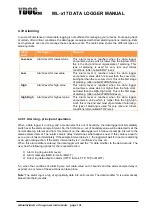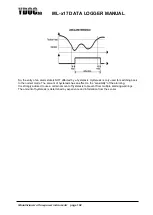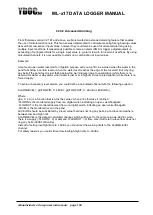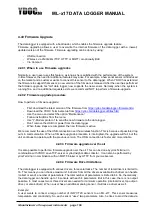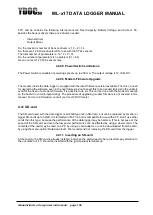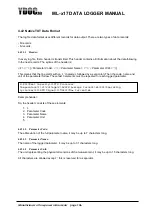
ML-x17 DATA LOGGER MANUAL
Manufacturers of low power instruments
page 107
4.42.2 D-Records
Most of the data is logged into D-records. D-records stand for Data records. The syntax of this record is;
<’D’> <’;’>,<Timestamp> <’;’> [ <Parameter Code> <’;’> < Parameter Value >[<Data Modifier>] <’;’>]
So, the D-
record consists of a ‘D’ character followed by a timestamp, and after that, one or more series of
parameter code and parameter name. So, the D-record consists of these elements:
1. D
2. Parameter Code
3. Parameter Value
4. Optional Data Modifier
5. ;
4.42.2.1
Parameter Code:
The abbreviation of the full parameter name, it may be up to 7 characters long.
4.42.2.2
Parameter value:
The numeric value of the measurement, together with a optional data modifier, forms the measurement.
Example Data-record(s):
4.42.3 System records
The System-records are used to log system related information. System-records do not contain normal
measurements. A system-record is made, when a deviating situation has occurred, for instance, when a
sensor is not replying to a request from the logger. System-records are used for monitoring system-
performance.
The syntax of an S-record is:
S;<Timestamp>;<Message code>[;<Supplemental code or text;[
”<Explanatory text>”]]
So, the S-
record consists of an ‘S’ character followed by a timestamp, and after that, one or more series of
parameter code and parameter name.
So the S-record consists of these elements
1. S (to distinguish a system record from a data record)
2. Timestamp (yymmddhhss)
3. Message code
4. Optional supplemental code or text
5. Optional explanatory text
See Appendix ‘System messages’ for a list of possible messages and their meanings.
D;110928030200;RCi;95.8;PTi;50.1;Vi;3.6;AVGCi;71;OCi;0.25;MAXCi;71
D;110928030300;RCi;95.8;PTi;49.3;Vi;3.6;AVGCi;71;OCi;0.25;MAXCi;72
D;110928030400;RCi;95.8;PTi;49.5;Vi;3.6;AVGCi;72;OCi;0.25;MAXCi;72
D;110928030500;RCi;95.8;PTi;49.1;Vi;3.6;AVGCi;72;OCi;0.25;MAXCi;54
D;110928030600;RCi;95.8;PTi;49.1;Vi;3.6;AVGCi;54;OCi;0.25;MAXCi;72









